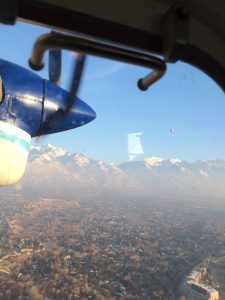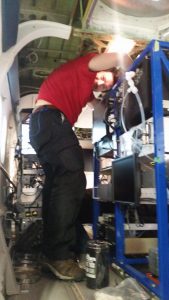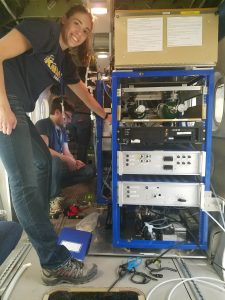
A balloon ride over a Salt Lake City inversion
In winter, Salt Lake City suffers from inversion events, which trap air pollutants low to the ground and cause buildup of particulate matter in the air. Particulate matter, known to atmospheric chemists as aerosols, has been shown to have strong influence on human health; for example, areas with higher particulate concentrations have higher mortality rates. We are in Salt Lake City to investigate the buildup of particulate matter during inversion events. We hope to determine which sources are contributing and how the geography and meteorology of the area influences air quality.
Aerosols are small particles suspended in air, and are typically less than 1% of the width of a human hair in diameter — far too small to be seen with the naked eye. There are two kinds of aerosol in the atmosphere: primary and secondary. Primary aerosols are directly emitted and include dust and soot. Secondary aerosols are formed from reactions between gas-phase chemical compounds in the atmosphere. By measuring both the gas-phase chemical species, and the chemical makeup of the aerosols, we can determine which atmospheric chemicals are forming the aerosols.

Ale preps the AMS for flight
To accomplish this, we have outfitted the Twin Otter with four major instruments and a few smaller measurements. Each instrument measures compounds that are thought to contribute to the aerosols in Salt Lake City’s air. With the spatial coverage provided by the aircraft, we are looking for where the compounds are coming from and how they contribute to aerosols.
From front to back in the aircraft we have the following instruments: Aerosol Mass Spectrometer (AMS), Iodide Chemical Ionization Mass Spectrometer (I– CIMS), Ammonia Quantum Cascade Laser (QCL), and Cavity Ring-down instrument for nitrogen oxides (NOxCaRD). There are also a few small instruments including a Ultra High Sensitivity Aerosol Spectrometer (UHSAS) and a meteorological probe.

Alex works on the Ammonia QCL during instalation
The AMS gives us chemical composition of the aerosols, so we can learn about the chemistry that is involved in their formation. The data from the AMS is complemented by the UHSAS, which gives the size distribution of the aerosols.

Erin installing NOxCaRD
The CIMS, Ammonia QCL, and NOxCaRD provide gas-phase measurements, which will help illuminate the influence of gas-phase compounds on aerosol formation. These instruments primarily measure various nitrogen containing compounds. NOxCaRD measures nitrogens oxides (NO, NO2, NOY) and ozone (O3). The QCL provides ammonia concentrations, which acts as a tracer for agricultural activity found in the valleys neighboring Salt Lake City. The CIMS measures nitric acid (HNO3), nitrous acid (HONO), and several nighttime nitrogen oxide species (N2O5, ClNO2). The CIMS also provides data on some non-nitrogen species including HCl. These compounds come from a variety of sources including cars, trucks, coal-fired power plants, oil heaters and wood burning.

Lexi working with the CIMS before the plane fills up
With the high spatial resolution gained from flying over the city, the data collected will allow us to determine which sources are contributing to the buildup of these species in and around Salt Lake City and how they influence secondary aerosol formation, which contributes to haze and health impacts.
